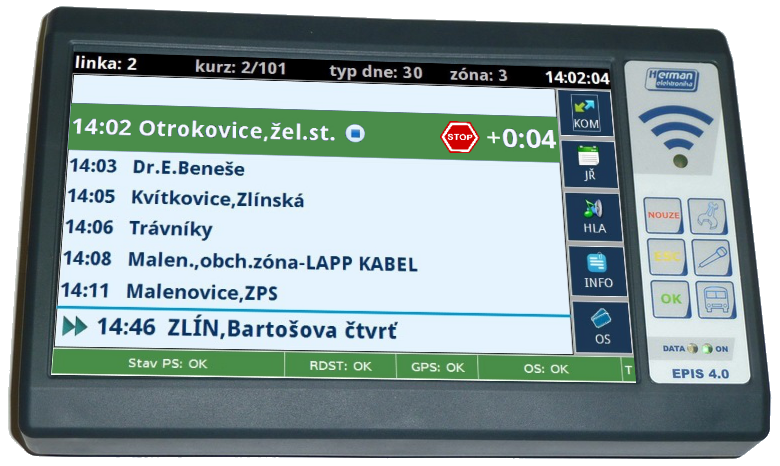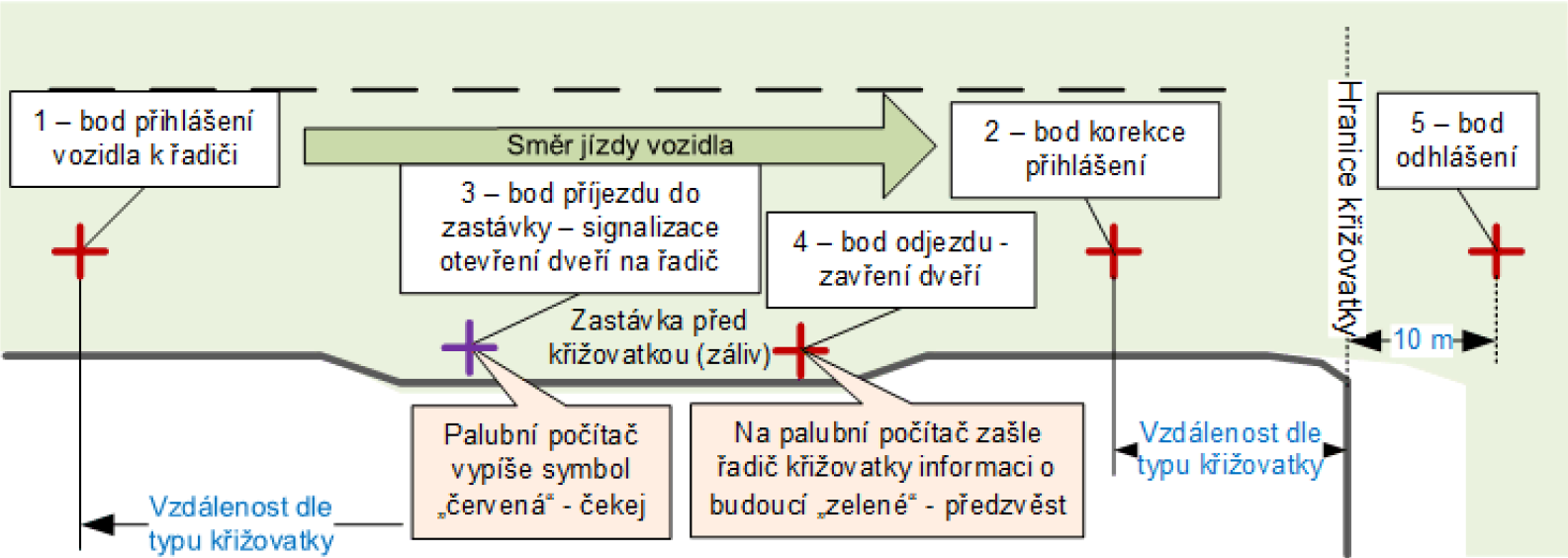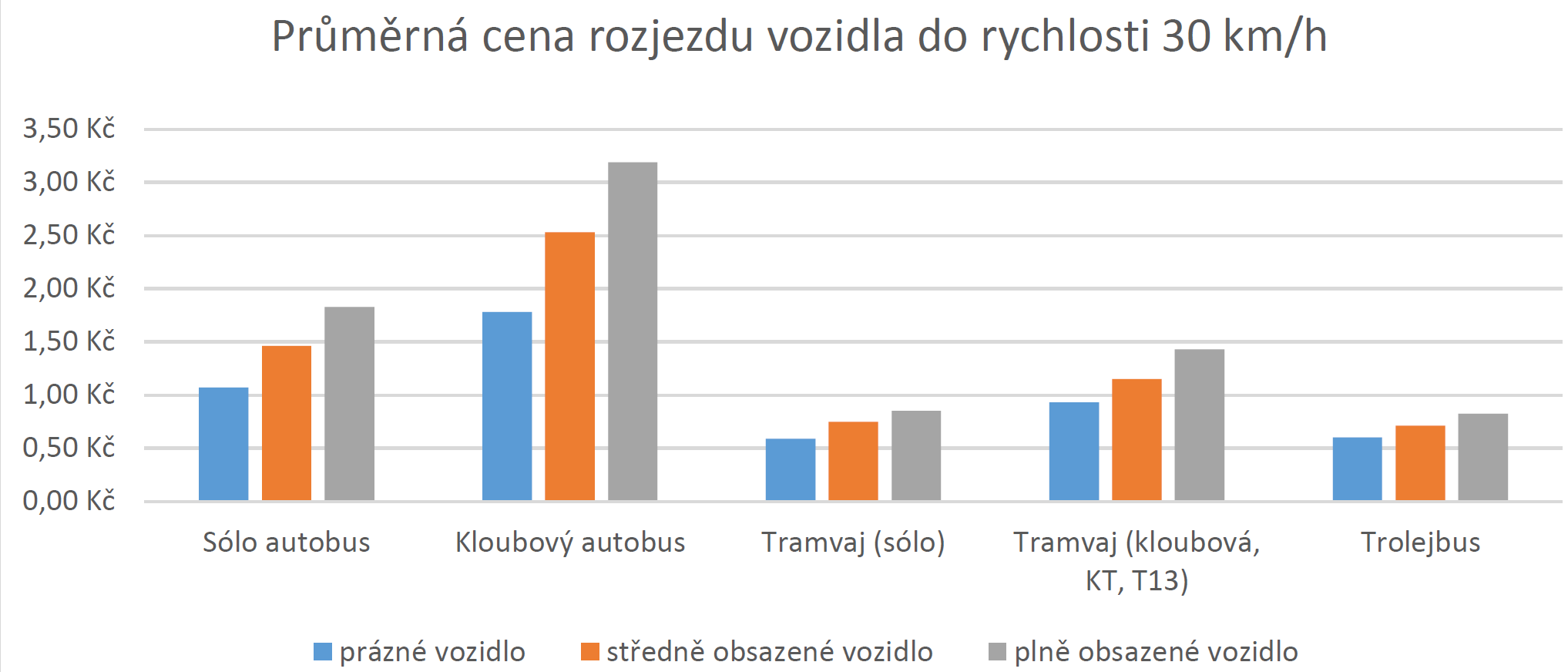Controlled stationing - optimisation of the passage through intersections
- Articles and technical information
- Articles
Public transport vehicles (public transport) after picking up passengers often leave the stop located in front of the intersection and immediately stop in front of the traffic light, where they wait for the green light. However, this time can be used to pick up additional passengers if the public transport vehicle would still spend it at the stop. In addition, starting the vehicle and stopping it again immediately leads to both higher consumption and higher wear and tear (braking system components, dynamics-prone components), as well as significant exhaust emissions. A way to reduce these situations is to implement the principle of 'vehicle stationing', which is part of the modern vehicle preference system.
The so-called public transport vehicle preference system is commonly used in many cities in different variants - with one-way or two-way communication between the public transport vehicle and the intersection controller. In the case of more frequent one-way vehicle communication with the intersection controller, the controller is only informed of the arrival of the vehicle. Based on the current internal state, the controller shall decide whether and which preference to assign to this vehicle. The vehicles are then only checked for the delivery of the request to the controller, but not for the outcome of the controller's decision. This communication has historically been implemented using conventional radio channels or radio data modems. The result of this communication could be either a green wave or a change of lights at a traffic light, which was only made known to the driver by a change in signal condition.
The possibility of using the new V2X technology for controlled stationing
Nowadays, this communication can be handled using the newly introduced international standards V2X or C2X (vehicle-to-vehicle communication) at 5.9 GHz. It is also a system that has been tested in the Czech Republic within the international C-ROADS project for the implementation of ITS systems in transport. The technology itself is designed for general vehicle-to-vehicle communication. All public transport vehicles in the Brno City Transport Company (DPMB) and the Ostrava Transport Company (DPO) are equipped with this communication technology.
Although the V2X system for public transport preference is used for the time being only within DPMB a.s., this technology brings several advantages:
- Standardization of the communication channel - the deployment of V2X technology brings the benefit of a clear definition of the communication channel. Several different preference methods are now used within the Czech Republic. This "inconsistency" introduces problems with the expansion of other preference participants into the system - the integrated rescue system or public line transport, whose vehicles also move in large cities. The V2X standard clearly defines the rules of communication and therefore the use of this technology removes the dependence on controller manufacturers, communication units or transport operators. It is up to the "city" how it wants to organise this traffic.
- Communication security - radio communication has brought with it new possibilities for direct communication, but security depended on the use of simple single-purpose communication protocols. Communication via V2X technology introduces security through asymmetric cryptography and the use of certificates with public and non-public keys (signatures). It is therefore not possible, without their knowledge, for this communication to be misused by any entities, for example, for preference (for other types, it is only a problem of technical means and how to analyse them appropriately).
- Digital communication - a form of classical radio communication brought with it a simple solution, but the radio signal, although operating on dedicated frequencies, is less resistant to interference. V2X technology is based on similar principles to Wi-Fi and is thus more reliable.
- Possibility of further development - the use of the V2X standard also allows for other functions determined by the characteristics of the protocol - e.g. tram collision detection evaluated from vehicle-to-vehicle communication, direct communication between vehicle and stop marker, etc.
What is 'controlled stationing' of public transport vehicles
The concept of 'controlled stopping' is not fully known to the public and is also difficult to understand from vehicle operations. However, its outcome can be interesting. It is based on intelligent communication between the public transport vehicle (and not only it) and the intersection controller - i.e. the little-used two-way communication between the public transport vehicle and the intersection controller (today deployed in Zlín, Jihlava or Ostrava). What is meant by the term "controlled stopping" we understand:
- Theterm controlled stopping in the context of public transport has the meaning of "passing through an intersection with a previous stop at a stop". It means that the vehicle stops at a stop before the intersection (in its 'bay' or on an island at a separate body).
- Theprinciple of controlled stopping is to coordinate the departure of the public transport vehicle from the stop before the intersection. The vehicle will only leave when it receives a "command" from the intersection controller. The stopping system itself is thus not (or does not need to be) directly linked to the preference of the public transport vehicle, but allows optimisation of its exit.
- Theadvantages of controlled stopping are twofold - this principle allows more comfortable boarding of passengers, when the vehicle does not leave the stop prematurely and stays there for a longer period of time, and at the same time prevents double departure of the public transport vehicle - first to the traffic light of the intersection and then to the "green light". This makes public transport slightly more attractive for the passenger and also more environmentally friendly for the vehicle and the environment, bringing environmental and economic benefits.
How controlled stopping works (function of individual points):
1) Before arriving (1) at the stop, the vehicle announces itself to the intersection controller. In this case, there is a stop between the first check-in point and the second check-in point (check-in correction point).
2) The vehicle is instructed by the controller to remain in bay (3) until told otherwise by the controller. The driver is informed of this situation on the on-board computer display - it is "red". He is still at the stop, his doors are open and passengers can board.
3) The vehicle is informed that it can start on route (4), as there will be a "green light" in its direction in x seconds. It is therefore given a "guaranteed" green light and is free to pass through it on arrival at the intersection. The driver will receive the information again via the on-board computer.
4) The vehicle informs the controller of its departure from the stop and position on the line (point 2) and of its passage through the intersection (point 5). Should the vehicle be delayed at the stop for any reason, then the whole cycle is repeated until the vehicle has used it.
A description of a practical test of controlled stopping using V2X communications from the city of Ostrava is described here, where it was shown to be applicable to this mode of operation as well.
Controlled parking - not only economic benefits
As mentioned: if "controlled stationing" is not applied, from the driver's behavioural point of view, it means that he closes the doors after passengers have boarded and "pulls out" to the intersection, i.e. starts and often brakes again. The cost of starting the vehicle to reach a certain speed can be quantified from the cost of fuel/energy and its consumption. The consumption then varies according to the technical condition of the vehicle and its weight, which is strongly influenced by its occupancy. If we look at how much it costs to run a vehicle up to 30 km/h, these are not negligible amounts (prices are from 2018 and have been averaged for different vehicle categories by traction for simplicity of display):
Just as an aside - the above graph shows that the "most expensive" start-up is a bus, and that electric vehicles are more environmentally friendly.
Let's take a practical example of trams from a given intersection, which is crossed by specific types of vehicles (coupled trams, T13, K2, Anitra, Varia articulated and KT8 trams). On average, these types of trams cost CZK 1.56 to start up for a fully occupied vehicle up to 30 km/h.
As an example, we will focus on the Pekařská - Úvoz intersection, which is located in Brno and is suitable for the implementation of a station. Currently, with limited traffic on Covid-19, there are a total of 538 tram passes on weekdays and 404 tram passes on days off when traffic lights control traffic.
If only 50% of the streetcars used the station as it stands today:
- 269 passes on weekdays and
- 202 passes on non-working days.
If we convert this to the full year 2020, which has 251 working days and 114 non-working days, we can calculate this cost by multiplying it by:
- 251 x 270 x 1.56 = 105 721,- CZK for working days and working days respectively.
- 114 x 202 x 1.56 = CZK 35 924,- for non-working days.
The sum of these costs can thus save up to 140 thousand CZK on average in electricity costs for one specific intersection and specific types of tram vehicles actually entering the site . CZK per year. Even if we consider statistically only 50% of trams that would use the principle of stationing, the number will be slightly lower, because not all drivers respect these principles and the tram is not always fully occupied. Further savings can then be found in the combination of lower wear and tear on the vehicle components.
What needs to be ensured for the "controlled stationing" function?
As mentioned above, controlled stopping is often associated with the public transport vehicle preference function. This functionality has gradually been derived in the implementation of preference. The ideal means to implement managed stationing is precisely the deployment of the standardised V2X communication technology described above.
In order to make the whole preference and tenting system work, the following modifications must be made:
- Adding a V2X communication unit to the vehicle (sometimes called an OBU - On Board Unit - in our case UCU 5.0).
- Modifying the behaviour of the on-board computer for the driver (transferring the "green" and "red" annunciators from the junction controller directly to the on-board computer screen).
- Addition of an RSU communication unit in the intersection controller to provide two-way V2X communication with vehicles.
- Modification of the software in the junction controller to communicate with the RSU (the controller must be capable of this) - in our case RSU - UCU 5.0.
So the controller must know that the vehicle is in the monitored section and be able to handle that information somehow. The vehicle, in turn, must know where it is in order to process these instructions, i.e. send an instruction, accept the instruction and then unambiguously inform the driver of the instruction to leave.
Conclusion
The described guided stationing system(verification described here), even if it does not provide a preference for public transport, will still make travelling more pleasant for people and, in addition, will provide operational savings in energy (electric, diesel or gas). It will make the operation of public transport much cleaner, especially buses.
The system thus brings additional, non-economic aspects, which are:
- Comfortable passenger boarding - the vehicle can stay longer at the bus stop and passengers can board comfortably.
- Reduced emissions and noise from road vehicles - every time a vehicle starts up, there is increased exhaust fumes or energy consumption or noise from starting engines.
- Traffic safety - each organised exit from an intersection will make crashes less likely and drivers will not be forced to run amber lights.
From the above calculations, it is clear that even with one-off investments in new vehicle and intersection technologies, the economic benefits can be expected to pay for the technological development itself.
About the authors' company
Herman has significant experience with functionality related to public transport stationing and preference. One of the first implementations of "controlled stationing" was deployed in Zlín, followed by Jihlava and Ostrava, within the framework of classic radio operation. Deploying V2X technology, Herman has successfully implemented the integration of public transport and fire brigade (IZS) preferences with the participation of the C-ROADS project. As part of the solution, a new FW was developed for the V2X communication units at RSU junctions and the communication with the junction controllers (RSU - controller) was modified. The "stationing" function is in line with the use of V2X technology. In order to control the functions of V2X communications, the visualization program V2Deep was developed.
For more information about the stationing system, please visit www.herman.cz.
PS: The data on passes and consumptions were provided by DPMB a.s.





